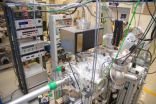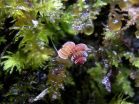(Press-News.org) WASHINGTON D.C., March 25, 2014 -- A research team in Spain has the enviable job of testing out new electromechanical gear for potential use in future missions to the "Red Planet." They do it within their Mars environmental simulation chamber, which is specially designed to mimic conditions on the fourth planet from the sun -- right down to its infamous Martian dust.
Mars is a key target for future space exploration, thanks to indications that the planet may have either been capable of supporting life in the past or is possibly even supporting it right now within its subsurface.
To answer the many questions about the habitability of Mars, it's critical to first develop new sensors and instruments capable of detecting the planet's atmospheric and surface characteristics. In the journal Review of Scientific Instruments, which is produced by AIP Publishing, researchers from Centro de Astrobiología, INTA-CSIC, and Instituto de Ciencias de Materials de Madrid describe their work mimicking conditions on Mars.
"Mars is a good place to learn about planets similar to ours and, as such, is the target of many NASA and European Space Agency missions," explained Jose Angel Martín-Gago, a research professor at the Instituto de Ciencias de Materials de Madrid. "Our group is primarily involved in the Mars Science Laboratory mission to construct a meteorological station intended for future use on a rover to further explore Mars' surface."
By building here on Earth state-of-the-art vacuum chambers capable of reproducing the physical conditions of Mars -- including temperature, pressure, gas composition, and radiation -- the researchers can experimentally mimic these conditions to test instrumentation in "real" environmental operation conditions.
Vacuum chambers have already enabled the researchers to test some of the meteorological sensors currently used onboard the Curiosity rover, which is exploring the surface of Mars. But they are now turning their attention to other challenges, such as Martian dust.
"We're simulating the effect of the Martian dust -- one of the primary problems for planetary exploration -- to gain a better understanding of how instruments behave when covered in dust," said Jesus Sobrado, the scientist in charge of the machine's technical development.
As part of its research effort, the team has designed and built vacuum chambers devoted to simulating spatial environments, such as the surface of other planets like Mars' surface or even Jupiter's icy moon Europa, the interstellar medium, and interplanetary regions.
Vacuum chambers can "answer many questions about Mars or other related planetary bodies -- both from scientific and technology points of view," he added.
Martín-Gago and colleagues are currently collaborating with NASA on its mission to test the new meteorological station "Temperature and Wind for Insight," associated with the Insight mission, and are also expected to test the Mars Environmental Dynamics Analyzer and Sign of Life Detector instruments proposed for the next mission to Mars in 2020.
INFORMATION:
The article, "Mimicking Mars: A vacuum simulation chamber for testing environmental instrumentation for Mars" is authored by J.M. Sobrado, J. Martín-Soler, and J.A. Martín-Gago. It will be published in the journal Review of Scientific Instruments on March 25, 2014 (DOI: 10.1063/1.4868592). After that date, it can be accessed at: http://tinyurl.com/p8eluz8
ABOUT THE JOURNAL
The journal Review of Scientific Instruments, which is produced by AIP Publishing, presents innovation in instrumentation and methods across disciplines. See: http://rsi.aip.org/
Mars-mimicking chamber explores habitability of other planets
Researchers in Spain have designed a vacuum chamber capable of mimicking conditions on Mars to test gear for use in future missions
2014-03-25
ELSE PRESS RELEASES FROM THIS DATE:
Malaysian microjewels going extinct as they are discovered
2014-03-25
A Malaysian-Dutch team of biologists have catalogued all 31 species of the tiny, but oh so pretty snail genus Plectostoma from West-Malaysia, Sumatra, and Thailand. Ten species are new to science, but some of those are going extinct as they are being discovered.
The study was carried out by PhD student Thor-Seng Liew of Naturalis Biodiversity Center in Leiden, The Netherlands, and three colleagues. Liew, who is on study leave from Universiti Malaysia Sabah, spent four years studying the distribution, shell shape, and genetics of these minuscule snails. He is still working ...
First stem cell study of bipolar disorder yields promising results
2014-03-25
ANN ARBOR, Mich. — What makes a person bipolar, prone to manic highs and deep, depressed lows? Why does bipolar disorder run so strongly in families, even though no single gene is to blame? And why is it so hard to find new treatments for a condition that affects 200 million people worldwide?
New stem cell research published by scientists from the University of Michigan Medical School, and fueled by the Heinz C. Prechter Bipolar Research Fund, may help scientists find answers to these questions.
The team used skin from people with bipolar disorder to derive the first-ever ...
Fewer children at risk for deficient vitamin D
2014-03-25
MAYWOOD, Il. – Under new guidelines from the Institute of Medicine, the estimated number of children who are at risk for having insufficient or deficient levels of vitamin D is drastically reduced from previous estimates, according to a Loyola University Chicago Stritch School of Medicine study.
The study, led by Holly Kramer, MD, MPH and Ramon Durazo-Arvizu, PhD, is published online ahead of print in the Journal of Pediatric Endocrinology and Metabolism.
New Institute of Medicine guidelines say most people get sufficient vitamin D when their blood levels are at or ...
Black markets for hackers are increasingly sophisticated, specialized and maturing
2014-03-25
Black and gray markets for computer hacking tools, services and byproducts such as stolen credit card numbers continue to expand, creating an increasing threat to businesses, governments and individuals, according to a new RAND Corporation study.
One dramatic example is the December 2013 breach of retail giant Target, in which data from approximately 40 million credit cards and 70 million user accounts was hijacked. Within days, that data appeared -- available for purchase -- on black market websites.
"Hacking used to be an activity that was mainly carried out by individuals ...
Lick's new Automated Planet Finder: First robotic telescope for planet hunters
2014-03-25
Lick Observatory's newest telescope, the Automated Planet Finder (APF), has been operating robotically night after night on Mt. Hamilton since January, searching nearby stars for Earth-sized planets. Every night the fully autonomous system checks the weather, decides which stars to observe, and moves the telescope from star to star throughout the night, collecting measurements that will reveal the presence of planets. Its technical performance has been outstanding, making it not only the first robotic planet-finding facility but also one of the most sensitive.
The search ...
Stink bug traps may increase damage to tomato fruits
2014-03-25
The invasive brown marmorated stink bug (Halyomorpha halys) is an important pest of fruits and vegetables. To counter them, some home gardeners use pheromone-baited traps that are designed to attract, trap, and kill them. However, new research from entomologists at the University of Maryland suggests that the traps may actually increase stink bug damage to tomatoes. The research will appear in the April issue of Environmental Entomology (DOI: http://dx.doi.org/10.1603/EN13237).
The researchers asked 15 gardeners to place stink bug traps at the ends of rows of tomatoes, ...
New method yields potent, renewable human stem cells with promising therapeutic properties
2014-03-25
New Rochelle, NY, March 24, 2014—The curative and therapeutic potential of mesenchymal stem cells (MSCs) offers much promise, as these multipotent cells are currently being tested in more than 300 clinical trials in a range of diseases. A new, easier, and more reliable way to make large quantities of highly potent MSCs could accelerate progress toward their use in regenerative medicine, as described in an article in Stem Cells and Development, a peer-reviewed journal from Mary Ann Liebert, Inc., publishers. The article is available on the Stem Cells and Development website.
Robert ...
The fundamentals of facial recognition
2014-03-25
When it comes to recognizing faces, humans are extraordinarily skillful. It's no surprise – after all, from the moment humans leave the womb, the infant brains already have a preference for faces, and over the course of a lifetime, the average person sees hundreds of thousands of faces.
Among scientists, however, the question of exactly how humans came to possess this amazing ability remains a divisive one, with some researchers claiming our extraordinary abilities result from the operation of mechanisms specialized just for faces, whereas others argue that recognition ...
Study finds gout drug may reduce risk of death
2014-03-25
(Boston)--In a recently to be published study in Annals of the Rheumatic Diseases, researchers have found the use of the drug allopurinol was associated with a reduced risk of death in hyperuricemic (gout) patients. The study, the first in a general population, has found the overall benefit of allopurinol on survival may outweigh the impact of rare serious adverse effects.
Researchers from the Section of Rheumatology and Clinical Epidemiology at Boston University School of Medicine (BUSM) contributed to this study.
Gout has been associated with an increased risk of ...
NOAA led study: Crude oil causes developmental abnormalities in large marine fish
2014-03-25
Crude oil from the 2010 Deepwater Horizon disaster causes severe defects in the developing hearts of bluefin and yellowfin tunas, according to a new study by a team of NOAA and academic scientists.
The findings, published in the Proceedings of the National Academy of Sciences on the 25th anniversary of the Exxon Valdez oil spill, show how the largest marine oil spill in United States history may have affected tunas and other species that spawned in oiled offshore habitats in the northern Gulf of Mexico.
Atlantic bluefin tuna, yellowfin tuna, and other large predatory ...
LAST 30 PRESS RELEASES:
Manta rays create mobile ecosystems, study finds
Study: Mixed results in using lipoic acid to treat progressive multiple sclerosis
Norbert Holtkamp appointed director of Fermi National Accelerator Laboratory
New agentic AI platform accelerates advanced optics design
Biologists discover neurons use physical signals — not electricity — to stabilize communication
Researchers discover that a hormone can access the brain by hitchhiking
University of Oklahoma researcher awarded funding to pursue AI-powered material design
Exploring how the visual system recovers following injury
Support for parents with infants at pediatric check-ups leads to better reading and math skills in elementary school
Kids’ behavioral health is a growing share of family health costs
Day & night: Cancer disrupts the brain’s natural rhythm
COVID-19 vaccination significantly reduces risk to pregnant women and baby
The role of vaccination in maternal and perinatal outcomes associated with COVID-19 in pregnancy
Mayo Clinic smartwatch system helps parents shorten and defuse children's severe tantrums early
Behavioral health spending spikes to 40% of all children’s health expenditures, nearly doubling in a decade
Digital cognitive behavioral treatment for generalized anxiety disorder
Expenditures for pediatric behavioral health care over time and estimated family financial burden
Air conditioning in nursing homes and mortality during extreme heat
The Alps to lose a record number of glaciers in the next decade
What makes a good proton conductor?
New science reporting guide published for journalists in Bulgaria
New international study reveals major survival gaps among children with cancer
New science reporting guide published for journalists in Turkey
Scientists develop a smarter mRNA therapy that knows which cells to target
Neuroanatomy-informed brain–machine hybrid intelligence for robust acoustic target detection
Eight SwRI hydrogen projects funded by ENERGYWERX
The Lundquist Institute and its start-up company Vitalex Biosciences Announces Strategic Advancement of Second-Generation fungal Vaccine VXV-01 through Phase 1 Trials under $40 Million Competitive Con
Fine particles in pollution are associated with early signs of autoimmune disease
Review article | Towards a Global Ground-Based Earth Observatory (GGBEO): Leveraging existing systems and networks
Penn and UMich create world’s smallest programmable, autonomous robots
[Press-News.org] Mars-mimicking chamber explores habitability of other planetsResearchers in Spain have designed a vacuum chamber capable of mimicking conditions on Mars to test gear for use in future missions




